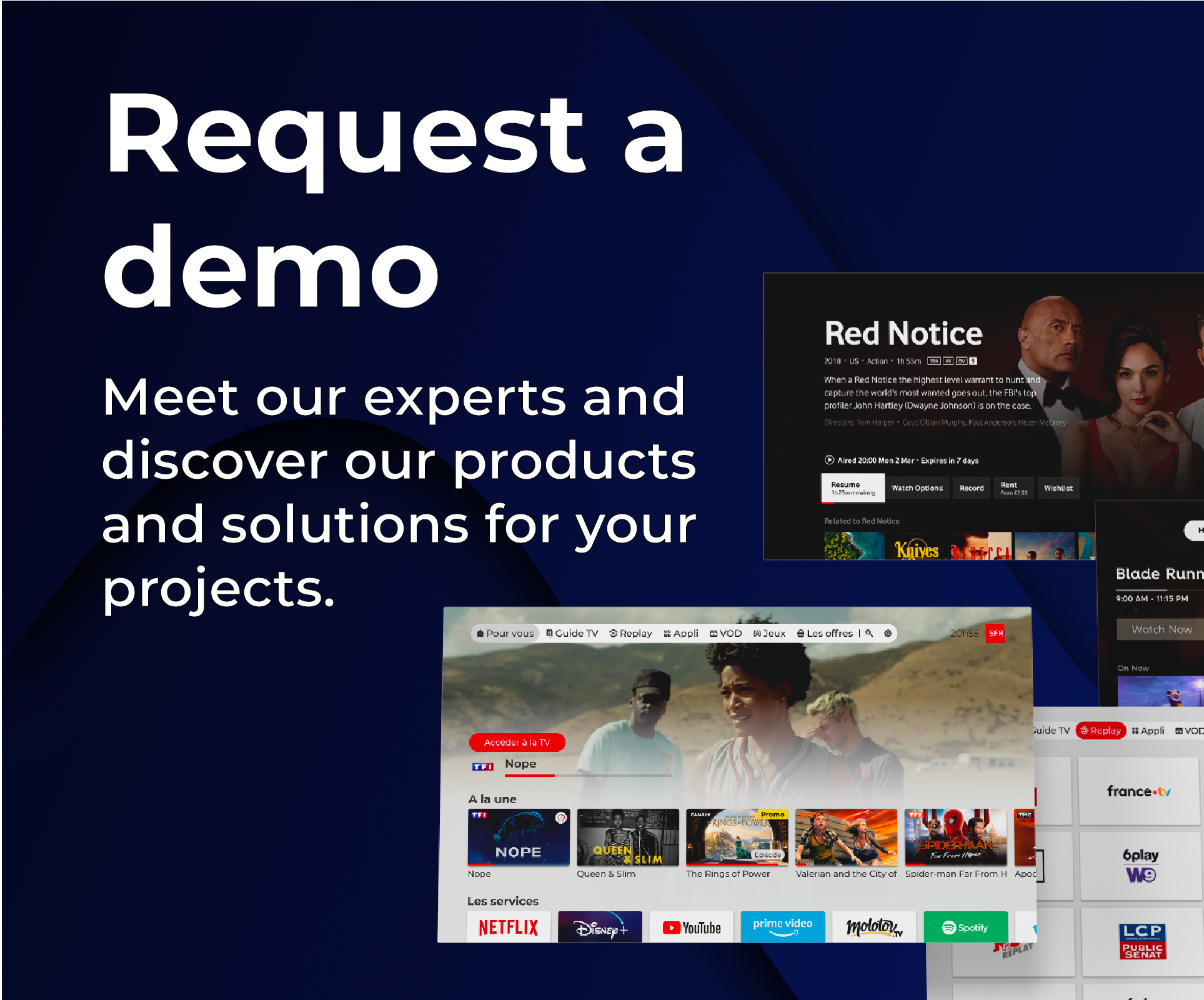The pay-TV market continues to grow. Developing a pay TV service on Smart TV is an extraordinary opportunity for content providers looking to maximise their reach and generate new streams of revenue in a digital-first economy.
>> Download: “Tactical guide, the 5 best practices for a unified cross-device strategy”
According to Strategy Analytics, more than 665 million homes worldwide owned a Smart TV at the end of 2020 and this figure has continued to increase since then. 34% of global households use Smart TVs, projected to rise to 51% by 2026, reaching 1.1 billion homes.
The benefits of bringing a Pay TV service to market in this climate are numerous: technology advances have removed the need for a set-top box (STB), lowering device purchase costs and spurring sales. In spite of our device-saturated society, the TV still remains untouched as a communal entertainment option. It ensures no cannibalisation between a Smart TV offering and web and mobile products. In addition, the continuous innovation of new and exciting TV features ensures an ever-evolving and satisfying user experience.
So far so good. Connected TV growth is exciting, with an unprecedented abundance of over-the-top (OTT) content for consumers to choose from. However, significant market growth brings stiff competition and spiraling complexity. Manufacturers must choose between maintaining their ecosystems or licensing from third-party partners.
As Smart TV continues on a steady trajectory to becoming the preferred platform for accessing video content, platform providers face a significant challenge in driving engagement and reducing subscriber churn. As in any ecosystem, only those providers that can adapt to change will survive.
In this blog post we will explore the key aspects you must consider when developing your Pay TV service. Utilize this insight to sidestep pitfalls and build a beloved Connected UI that fosters audience loyalty.
This article covers the following topics:
- Choose your Smart TV platform or OS
- Connect with Smart TV manufacturers
- Be mindful of device-specific features and functionalities
- Final thoughts
- Download our tactical guide
1. Choose your Smart TV platform or OS
Samsung was the leading Smart TV manufacturer in terms of annual sales units for the eleventh straight year in 2022, with Chinese giant TCL coming in second and LG third. Samsung’s proprietary OS Tizen, LG’s WebOS and Google’s Android OS are fiercely competing for market share, leading to a fragmented market and introducing complexity for new developers.
Why is this? Well, just like mobile development, every individual OS requires its own application. At the roadmap's start, decide which OS or platform to target for your development, shaping your direction from the beginning. Will it be for one? Will it be for all?
Think carefully about this. Consider not only the initial build but also the rollout of updates. This can cause unforeseen issues with applications and ongoing maintenance costs. TV upgrades are similar to mobile phone upgrades, in that some consumers will upgrade regularly whereas others will do so only sparingly, meaning that not all apps or APIs will be available to everyone. Both out-of-date (such as Android’s KitKat or Lollipop) and cutting-edge technologies must be taken into account for the best possible user experience.
Choosing the right partner can go a long way towards navigating this constantly shifting complexity. When vetting potential partners, ensure they have the correct skill sets and track records for developing Smart TV applications and user interfaces (UIs). Skills you should vet for include:
- Knowledge of platform-specific SDKs,
- Strong knowledge of HTML5 gained while working on Smart TV app development,
- Familiarity with software architecture for Smart TV applications,
- Comprehensive understanding of complex JavaScript applications for creating an immersive and rich Smart TV app with high interactivity,
- Ability to optimise UI performance over a wide range of products with heterogeneous features and power e.g. ensuring performance is smooth across both old and new OS versions,
- Experience in dealing with the challenges of performance, rendering and DRM support across a multitude of devices.
Noteworthy: there are also signs that the market is beginning to coalesce around a handful of dominant platforms. The best example is Google’s Android TV OS reporting 35% year-over-year growth. With so many big players, we can expect the mind-boggling choice of operating systems and platforms to naturally reduce in the mid to long-term.
2. Connect with Smart TV manufacturers
Just as they do for mobile applications, TV manufacturers set rules and guidelines for TV app development, such as these technical and design principles used for Tizen apps.
Compliance is essential – not only to avoid rejection from your chosen store but also to maximise the chance of free or discounted marketing promotion from the manufacturer.
Yes, manufacturers can and do offer incentives to apps and brands to develop for their platform. Some also offer incentives based on user data. Therefore, creating an app that makes both the consumer and the host happy is a must.
How to do this? Well, beyond complying with development guidelines for your chosen platform or OS, and ensuring all updates are taken care of, it is important to cultivate a relationship with the manufacturer.
Remember that the TV app market is fierce and manufacturers are themselves incentivised to make deals with publishers to launch UIs on their platforms. Incentives to develop for a particular manufacturer may not be financial, but will come in the form of store promotions, development grants, or test devices to ensure your app is the best it can be.
Choosing the right development partner is once again the most important decision you can make when considering manufacturers. The app developers with track records of successful deployments will likely already be close with the people you need to talk to, and will be able to support you in building these relationships – as well as creating a product that works seamlessly in every environment.
3. Be mindful of device-specific features and functionalities
User experience (UX) is the first and last word when developing a Pay TV service. In a digital-first world where consumers are unforgiving and have abundant choice, UX needs to be fast, frictionless and ever-evolving.
What should you consider when thinking about UX? All manufacturers carry their own ideas about their customers and their needs, but in general there are best practices that should be followed regardless of platform – Samsung’s UX checklist is an excellent place to begin learning what works.
Unlike tablets and mobile, users interact with Smart TV apps via remote controls, which differ depending on the TV manufacturer. For example, LG has the Magic Remote and Samsung has the Universal Smart TV remote, both of which have their own unique features and function on different operating systems. They also have different physical designs, which you will need to test to ensure your navigation is up to scratch. Ask yourself:
- Can users easily navigate to all objects on each screen?
- Is movement between objects straightforward and predictable?
Aim to make the on-screen experience as smooth as possible, introducing easy log in flows and avoiding unnecessary additions like virtual keyboards. The UX should be fast and intuitive (latest best practice says that the UI must also be usable from at least ten feet away) with hardly any conscious thought by the user on ‘how’ they are doing what they are doing.
Consider also the video watching experience. Which streams are you using? What features or constraints are native to your chosen platform that you need to be aware of and may have an impact on the finished product? There are native, open source and paid solutions on the market, which all have various pros and cons. The choice of which player to choose is driven by performance and security constraints, low latency requirements and ad insertion capabilities. Different projects often require different player features and capabilities.
Finally, don’t neglect the feature to cast from your mobile device to your connected TV. Several cross-device solutions exist depending on the devices targeted, including Chromecast, AirPlay, Mimecast and others. Your development partner will be able to help choose the best option for your deployment.
Final thoughts
It is the perfect time to develop a Pay TV service for Smart TV. The market is healthier than ever, with extremely strong prospects, and consumers – as always – are hungry for new content.
Of course, there will be other things to consider on top of the points mentioned above – resource and budget allocation being primary – but by building a strong foundation and being mindful of the complex nature of the Smart TV environment, you will be equipped to build engaging and easy to use connected UIs that your audience will love.
Download our tactical guide
Developing a Pay TV Service for Smart TV is a long-term investment. It presents a significant growth opportunity in the next ten years. At Wiztivi, we help content providers and publishers to deliver exceptional viewer experiences with state-of-the-art UI technology and tools. See some of the global brands we have worked with.
Enjoyed this article? Delve deeper into the technical side of developing a Pay TV service, download our tactical guide. Don’t forget to discover how Timeless, our cutting edge UI product, can help you.




%20pour%20blog.png?width=1535&height=528&name=CTA%20DL%20Ebook%20UI%201%20(Tactical%20Guide)%20pour%20blog.png)